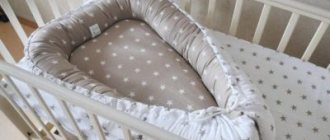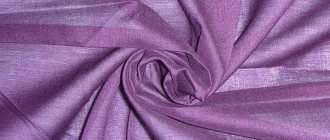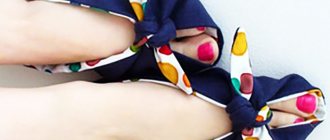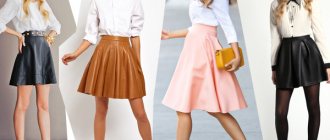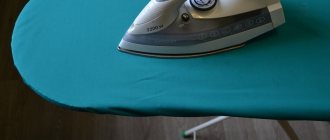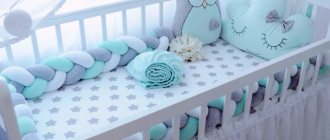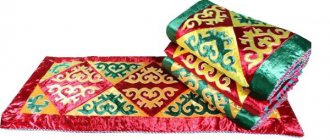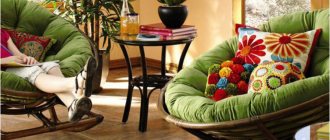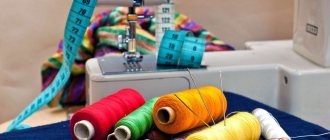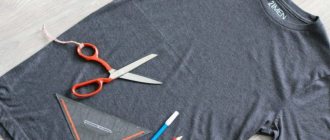For young parents, the arrival of a baby is always a very exciting moment. They are carefully preparing for the new addition to the family, trying to find the best things for the baby. Today, the anatomical cocoon nest for newborns has become very popular. It can be used from birth until 4-6 months.
Osteopaths and kinesiotherapists note that such mattresses will give your baby a healthy and sound sleep. They will also provide comfortable adaptation to the outside world, thanks to their special shape.
We sew a warm nest for newborns with our own hands
The closed shape of the nest is very comfortable for the baby; he takes the most physiological and correct position.
And the space around creates a feeling of warmth and comfort, similar to that which surrounded the child in the womb. Regardless of the size of the bed, the baby feels more protected and sleeps peacefully
This is extremely important for the child, since excessive anxiety leads to digestive dysfunction, colic and negatively affects the baby’s nervous system.
The nest is indispensable in cases where the child needs to sleep with his parents in bed, and at the same time separate his personal space. Parents are often afraid of disturbing the baby in his sleep, pinning him down or accidentally pushing him out of bed, so such a device will come in handy.
The nest will definitely come in handy when traveling if you need to spend the night in a hotel where there is no cot.
In addition to sleeping, such a nest is convenient to feed the baby and engage in its physical development (gymnastics, massage). This is especially true for night feedings if the mother finds it difficult to feed her baby while sitting. The sides will also provide support when placing the baby on his side, on his tummy, and will help him learn to hold his head up.
Beautiful ideas for nest colors for a boy and a girl can be seen in the photo:
To make a nest you will need:
- Two pieces of fabric (plain and patterned), measuring approximately 100 cm. For girls, it is customary to choose pink and lilac tones, for boys - blue and light blue. And shades of yellow, green, white and beige will be universal.
- Sintepon as a filler.
- Lace – 3 m.
- Bias binding – 2.6 m.
Description of the work progress.
We begin our master class by drawing a pattern according to the dimensions indicated in the photograph:
Using the pattern, we cut out 2 parts from different fabrics. Then they need to be basted, folded inside out and stitched, leaving the bottom part open (starting from the middle of the tongues).
Turning the work right side out, we sew bias tape along the seams on both sides.
We cut out a three-layer piece of padding polyester 30x60 cm for filling and round the corners.
Fill the mattress and stitch around it (approximately 15 cm from the edges).
Using a 200x60 cm padding polyester tube, we stuff the sides of the mattress. You can also use trimmings.
You need to insert a lace into the resulting “path” between the seam and the bias tape (using a pin). We machine sew the open edges and close the seams using bias tape.
By tightening the lace, we give the mattress the desired shape. The lace can be replaced with a beautiful ribbon.
The baby's nest is ready!
A large pattern of a nest for a baby looks like this:
These nest sizes are suitable for a child up to 6-7 months
When choosing a fabric, it is very important to pay attention to the fact that it is natural (preferably 100% cotton), soft and pleasant to the touch. You can use any cotton fabric, including calico, flannel
For decoration you can use ribbons and small embroidery.
How to sew a cocoon with Velcro:
This pattern will help you sew a cocoon nest with Velcro legs, which will also be very comfortable for a newborn and a child in the first months of life.
The dimensions of the cocoon are 85x60 cm. The legs do not need to be cut out separately, but the work can be done in the form of an envelope. To securely fix the cocoon on your head, you will need a cord for the hood.
For sewing, fleece, flannel, and fleece knitwear are used. In the cold season, it is recommended to make a double cocoon, consisting of a lining and main fabric. Such cocoons are very convenient for sleeping and attending doctor’s appointments, but you should not overuse them, since the baby needs to move actively and freely.
Cocoons for newborns can be knitted or crocheted. To do this, you need to choose soft hypoallergenic yarn. The measurements you need to use are the girth of the torso under the armpits and the length from the armpits to the heels. You can choose the pattern to your liking; patterns that are too large and complex can create uneven pressure on the baby’s skin and cause discomfort, so it’s worth choosing simpler ones (elastic band, rice pattern, etc.).
Features of ordering and delivery of products from our production
The wishes of each customer are important to us. We try to think through all the details: from a convenient order form on the company’s website to the opportunity to get answers to all your questions from experienced consultants by phone from the “Contacts” section.
Our company will produce inexpensive toy pillows in the shape of animals or letters of the baby’s name according to your sketches. It is also possible to sew all the accessories for a newborn’s crib at an affordable price in one color scheme that matches the interior design style of the children’s room and your wishes.
If you prefer a ready-made option from the many presented in the catalog, we will send the ordered goods within 24 hours to any region of Russia. Children's textiles are always needed by young parents, and delivered in a stylish carrying bag, there is no need for gift wrapping.
Maranis products are a pleasure to give and receive as gifts.
Cozy nests
When born, the baby experiences discomfort, because the mother’s belly was warm and safe. He felt that he was protected from all sides. In life, a mother cannot be nearby every minute; a nest for newborns will provide a feeling of comfort during sleep.
It is an anatomically shaped mattress. It follows the curves of the baby's body and has sides on all sides, so that the baby cannot fall out. Such mattresses were first invented by French doctors, but studies have shown that their use will also be beneficial for full-term babies.
What are the advantages of such a device:
- The child feels comfortable and calm;
- Children's sleep becomes stronger;
- The anatomical shape contributes to the correct formation of the spine;
- Reduces muscle hypertonicity;
- There is no risk of sudden respiratory arrest due to suffocation (SIDS);
- Reduces the incidence of colic;
- The risk of developing cranial pathologies is reduced.
The cocoon reminds the baby of being in the arms of his mother or in her womb. It makes it convenient to feed your baby. As for the disadvantages, they include:
- Cost – such products are more expensive than regular mattresses. The average price is 10 thousand rubles.
- Short lifespan – the nest lasts for about 2-3 months, until the baby starts to roll over.
- Some mothers note that the baby may feel hot in the cocoon.
An envelope or diaper - a cocoon for newborns - can partially take on all of the listed functions.
How to find a cocoon for newborns in Moscow at manufacturer’s price
Having decided on the advisability of purchasing a nest, you need to decide on choosing the best option from the options offered for sale. It is important that the product is of high quality, inexpensive, and that orders from the online store are accompanied by free delivery in Moscow. All these requirements are met by any product from our catalog, in which you will find a variety of cocoon nests for a baby’s daytime wakefulness and nighttime restful sleep.
Bedding for newborns and children's textiles produced by us have a number of advantages compared to other offers.
Review of popular models
Cocoonababy Red Castle
This is the quality of the French brand where it all began. The set consists of a pear-shaped base (polyurethane foam material, cotton pillowcase), a leg bolster (attached under the knees, adjustable for height), and a safety belt. The ergonomic dense base will not lose its shape. The position of the baby is such that the head and torso are located at the same level, and the slightly bent legs are higher. The weight of the mattress does not exceed a kilogram. The cocoon is universal in function (sleep, travel, wakefulness, visiting the doctor). Place him in a stroller for walks or in a crib, but don't leave him unattended! The only drawback will be the price - about 11 thousand rubles. Additional items included:
- Blanket CocoonaCover. A convenient device that fits onto the mattress and is fastened with Velcro at the bottom. The child will be comfortable, it warms well and does not slip. Made from 100% cotton.
- Spare pillowcase. It is necessary for frequent regurgitation, surprise when changing a diaper or feeding. It is easy to wash and does not require special care.
Cocoon "Yawn"
Our production “Cloud Factory”. When compared with, there will be the following differences:
- The price is almost 2 times lower (5-6 thousand rubles).
- Weight – “Yawn” is one kilogram heavier.
- Included: Our manufacturer has an additional pillowcase, which the French manufacturer does not have.
They are similar in appearance, almost identical in size. Our manufacturer has provided additional accessories: a “milk + stars” blanket, a “Lamb” rocking chair, a lightweight Simple cover, and a thick Heat cover.
Farla baby shell
Also a domestic product. The peculiarity of this model is the use of low elasticity polyurethane foam. This material is also included in orthopedic mattresses. There are cavities at its base for ventilation (the child sweats less and overheats in the heat). No glue is used when assembling the base (environmentally friendly Farla production). Additional accessories include: blanket, pillowcase, carrier.
Babynest for newborns
Swedish development since 2003. Many models are made in our country. There are large cocoons for twins. This is not an ergonomic mattress, but a soft flat nest with sides that can be tightened with a string. Like the classic cocoon, it is no less popular and wins in price (2 times lower). The base is made of cold foam, the cover is made of cotton, and the sides are made of holofiber.
Nest cocoon for newborn Sleepyhead
The company that came up with this product, Enfant Terrible Design, operates in Sweden. It was founded by Lisa Furuland, who came up with a multi-functional item for her young son. A special feature is the longest service life (up to 8 months, there are models up to 3 years). The non-ergonomic base and sides are made of antibacterial polyester fibers, and the removable cover is made of cotton.
- Sleepyhead Deluxe – cocoon from birth to 8 months
- Sleepyhead Grand – for older babies (8 months – 3 years)
The downside is the price. It reaches 11 thousand rubles. Using a cocoon for a long time is not always useful (and sometimes even harmful). Not all manufacturers are available on our market. It’s good that domestic products are not inferior to foreign ones in quality. World famous companies:
- Red Castle – France
- Woombie – USA
- Babynest and Sleepyhead – Sweden
Cocoon mattress from the manufacturer Woombie
The second most popular manufacturer is the American company Woombie. Their cocoon mattresses have similar properties. The price of these products is also quite high. Considering that the cocoon will be used for only four months, the cost turns out to be a strong argument in favor of finding a simplified analogue.
Cocoon - Mario's Cradle
The Askona company has developed a cocoon - the Mario cradle, the material is very high-quality hypoallergenic highly elastic foam, the nest was developed together with Russian neonatologists for a child from one to six months. The set includes two cushions for placing under the legs of a child for different ages and a removable cotton cover with a lock. Securing the child using a belt with silent Velcro. The price is 4,448 rubles, but the cost of the cocoon is often included in promotions.
Materials and tools for work
Any instruction for sewing a cocoon begins with a list of materials and tools necessary for the work.
Materials you will need:
- 2 pieces of fabric measuring 80×100 or 80×110 cm;
- about 3 meters of cord (can be replaced with satin ribbon or bias tape);
- about 1 meter of bias binding to match the main fabric;
- lace (optional);
- foam rubber measuring 70×40 and a thickness of 2 cm (can be replaced with rolled padding polyester with similar parameters);
- threads
If you have a sewing machine at home, you can try sewing a nest with your own hands
Tools you will need:
- paper (for transferring the pattern);
- tape measure;
- pattern;
- pen, chalk or pencil;
- scissors;
- awl;
- safety pin;
- tailor's pin;
- basting needle;
- sewing machine;
- iron.
But the most important thing, without which you should not even start work, is a template or diagram according to which the pattern will be made and, in fact, the product will be sewn. If you have certain knowledge and experience, you can make a pattern yourself or find it on one of the many sites on the Internet.
What does a cocoon nest look like and what does it consist of?
The nest cocoon is usually sewn in the shape of a boat. For the base, take a regular mattress or a pattern according to its shape. Soft edges are sewn on the sides.
- To make the mattress , hypoallergenic material (foam rubber) is used. Only environmentally friendly and non-toxic materials are used.
- For the sides, use holofiber (the filling is similar to padding polyester), their height should be about 15 cm.
- To upholster the cocoon-nest, it is better to use 100% cotton in pastel colors that will not irritate the child.
A feeling similar to being in the mother’s tummy is obtained by tightening the sides at the baby’s legs with the help of long ribbons or cords.
Pillow for the legs or chest of a newborn
The second pad is universal. While the baby is lying on his back, you can place it under the baby’s legs, this will make the baby’s gas flow easier. But when you lay him on his tummy or teach him to crawl, this bagel pillow is placed under the baby’s chest so that he does not fall on his side and tries to hold his head. Babies from 4 months leaning on such a pillow will try to pull their legs under them and push off, thereby preparing to crawl in the future.
rogalik.jpg
111.1 KiB
411 Downloads
Pillow for newborns under the baby's legs or elbows. Helps the baby maintain its shape, stretch out on its arms or raise its legs.
- We sew together two parts of the bagel, leaving a hole for turning it inside out.
- Turn it inside out and stuff the pillow.
- Sew up the hole in the bagel.
- It turns out that in today's master class we touched on three very useful devices for babies. Sew it and you won’t regret it.
Transformable envelope for newborn
There are other versions of this product, for example, this one.
Cut out rectangles of the same size from two canvases, rounding each one on one side. Choose your favorite applique and sew it onto the front side of the top rectangle. Place one cloth on the face, place sheet filler on top of it, cover with a second identical cloth, which must be placed wrong side up. Sew along the edge of this multi-layered “sandwich”, leaving the bottom small side unsewn. Turn the mattress into a cocoon through it, sew up these edges on your hands or, turning the edge inward, using a machine. Fold the bottom of this blanket up, sew a zipper on the right and left sides
When you place your child on this mattress, all you need to do is lift the bottom of the cocoon up and carefully fasten the zipper. In reverse order, you will unfasten the blanket to get the baby out.
Some parents want their children to be fashionable from an early age. To do this, you need to sew the envelope using the same principle - pull the upper corners towards each other, secure this part with two buttons and loops. The dark fabric is designed as a suit, the light background will serve as a shirt. All that remains is to make a butterfly-bow and a handkerchief from red material, and sew these accessories in place.
The seam at the top should be double, one line should be at such a distance from the second that the elastic would fit freely into the resulting space. Its ends need to be secured by sewing here. At the same time, pull the elastic a little to gather the fabric at the top of the envelope, turning the corner into a comfortable hood.
- braid;
- honeycomb;
- garter stitch;
- elastic band 2x2.
Step-by-step instruction
- Start knitting from the bottom, that is, from the part that will end up at the level of the baby’s armpits. Here you need to make a 2x2 rib pattern, that is, knit 2 knits, 2 purl.
- Next, a “pigtail” pattern is knitted, and between these two elements there is a “honeycomb” or other three-dimensional one. On the left, make a cross elastic, performing two rows with purl stitches and two rows with knit stitches.
- To make holes for the loops, cast off 2-3 loops, in the next row make the same number of yarn overs here, and in the third row knit these yarn overs according to the pattern.
- When you reach the top of the baby's back, perform the rib pattern, not only on the left, but also on the right. Here you need to knit, alternating, 2 rows with knits, two rows with purls.
- Once you have closed the loops, fold the top edges together and sew them together to create a hood. If you have not knitted an elastic band here, then pick up a loop along the edge and knit it at this stage.
- Sew buttons on the left side of the envelope, fasten them, threading them through the pre-formed loops.
Use garter stitch so you don't have to create ribbing at the bottom and sleeves. This pattern is perfect for beginners.
Having knitted the sleeves of the required width, close the loops on the right and left, then continue to knit only the back. Now all you have to do is tie the loops of the “tongue” onto the front neckline, here you will sew buttons to fasten the sweater on the child after he has been dressed. Sew the sleeves at the seams, this is what a wonderful knitted product you will get for your baby.
You can knit the two halves of the shelf separately, without making a “tongue” for the fastener. You will create it using loops knitted on the front placket and buttons sewn on the other side.
We sew a warm nest for newborns with our own hands
The closed shape of the nest is very comfortable for the baby; he takes the most physiological and correct position. And the space around creates a feeling of warmth and comfort, similar to that which surrounded the child in the womb.
Regardless of the size of the bed, the baby feels more protected and sleeps peacefully
This is extremely important for the child, since excessive anxiety leads to digestive dysfunction, colic and negatively affects the baby’s nervous system.
The nest is indispensable in cases where the child needs to sleep with his parents in bed, and at the same time separate his personal space. Parents are often afraid of disturbing the baby in his sleep, pinning him down or accidentally pushing him out of bed, so such a device will come in handy.
The nest will definitely come in handy when traveling if you need to spend the night in a hotel where there is no cot.
In addition to sleeping, such a nest is convenient to feed the baby and engage in its physical development (gymnastics, massage). This is especially true for night feedings if the mother finds it difficult to feed her baby while sitting. The sides will also provide support when placing the baby on his side, on his tummy, and will help him learn to hold his head up.
Beautiful ideas for nest colors for a boy and a girl can be seen in the photo:
To make a nest you will need:
- Two pieces of fabric (plain and patterned), measuring approximately 100 cm. For girls, it is customary to choose pink and lilac tones, for boys - blue and light blue. And shades of yellow, green, white and beige will be universal.
- Sintepon as a filler.
- Lace – 3 m.
- Bias binding – 2.6 m.
Description of the work progress.
We begin our master class by drawing a pattern according to the dimensions indicated in the photograph:
Using the pattern, we cut out 2 parts from different fabrics. Then they need to be basted, folded inside out and stitched, leaving the bottom part open (starting from the middle of the tongues).
Turning the work right side out, we sew bias tape along the seams on both sides.
We cut out a three-layer piece of padding polyester 30x60 cm for filling and round the corners.
Fill the mattress and stitch around it (approximately 15 cm from the edges).
Using a 200x60 cm padding polyester tube, we stuff the sides of the mattress. You can also use trimmings.
You need to insert a lace into the resulting “path” between the seam and the bias tape (using a pin). We machine sew the open edges and close the seams using bias tape.
By tightening the lace, we give the mattress the desired shape. The lace can be replaced with a beautiful ribbon.
The baby's nest is ready!
A large pattern of a nest for a baby looks like this:
These nest sizes are suitable for a child up to 6-7 months
When choosing a fabric, it is very important to pay attention to the fact that it is natural (preferably 100% cotton), soft and pleasant to the touch. You can use any cotton fabric, including calico, flannel
For decoration you can use ribbons and small embroidery.
How to sew a cocoon with Velcro:
This pattern will help you sew a cocoon nest with Velcro legs, which will also be very comfortable for a newborn and a child in the first months of life.
The dimensions of the cocoon are 85x60 cm. The legs do not need to be cut out separately, but the work can be done in the form of an envelope. To securely fix the cocoon on your head, you will need a cord for the hood.
For sewing, fleece, flannel, and fleece knitwear are used. In the cold season, it is recommended to make a double cocoon, consisting of a lining and main fabric. Such cocoons are very convenient for sleeping and attending doctor’s appointments, but you should not overuse them, since the baby needs to move actively and freely.
Cocoons for newborns can be knitted or crocheted. To do this, you need to choose soft hypoallergenic yarn. The measurements you need to use are the girth of the torso under the armpits and the length from the armpits to the heels. You can choose the pattern to your liking; patterns that are too large and complex can create uneven pressure on the baby’s skin and cause discomfort, so it’s worth choosing simpler ones (elastic band, rice pattern, etc.).
Pattern of a cocoon-nest for a baby
Before you sew a cocoon-nest for newborns with your own hands, you need to prepare a pattern. For our master class we will use the “Standard” stencil. All sizes are shown in the diagram; they can be changed based on the individual characteristics of the child.
Pattern of a cocoon-nest for newborns PHOTO: sasha-mamasha.blogspot.com
Making a nest for newborns with your own hands
Let's look at the stages of cutting fabric and sewing a nest for a child in more detail.
| Illustration | Description of action |
| Fold two types of different fabrics in half lengthwise, face inward, and pin each fabric separately with needles. | |
| Attach the cocoon-nest pattern with the long side to the fold, circle it with a marker, connect the cuts together with pins and cut out all 4 layers at once. Mark the top points of the sides with a marker | |
| Break off the pins, unfold the fabric, fold the cuts together, pin along the perimeter and stitch from mark to mark along the outside | |
| Make several notches at the bends and press the seams | |
| Turn the workpiece right side out and sew bias tape on both sides, the seam should be exactly in the middle | |
| Spread the cocoon very evenly, pin it together with pins, attach the pattern of the sides and trace the inside on both sides | |
| Sew the middle of the nest, going slightly over the sides | |
| Pin a pin to a satin ribbon 2-3 cm wide and insert it into the bias tape. Cut the ends of the ribbon into a corner and lightly burn it with a match. | |
| Fill the sides tightly on both sides with holofiber. In the lower part, push aside the filling, fasten the unstitched areas with pins, stepping back inward from the seam allowance of 1 cm | |
| Transfer the pattern onto foam rubber 2 cm thick, step back 1 cm inward from each edge and cut out the mattress | |
| Insert foam rubber inside the cocoon, move it away from the seam allowance line and pin it together with pins | |
| Sew a straight line on a machine according to the markings from our marks; you cannot break off the pins | |
| Iron the bias tape, but not in half; one edge should be 1 mm shorter than the other. Pin the bias tape to the cut edge with pins, baste and sew along the short side using a machine. | |
| Break off the pins, straighten the filling and tie the cocoon with satin ribbons |
Advantages of cocoons at Maranis
- We make nests for your babies from high-quality factory-made fabrics from Turkey, Korea, and Poland. The material of the product covers is harmless to newborns, does not fade and retains its bright color after washing;
- We use certified filler, and not analogues that cost less. Holofiber eliminates the occurrence of allergic reactions and provides the necessary combination of softness and elasticity of pillows, bumpers, and cocoons for babies;
- handmade by highly qualified craftsmen and control at every stage of sewing allows us to guarantee the quality of each item from the large catalog of our online store at a low price.

